With recent changes in the GPU market, including the latest Etherium merge, prices are dropping, and many of us (me included) are looking to find a good deal to finally complete that long-awaited upgrade. And, because the newest generation cards are still out of reach for many of us, we turn to older cards hoping we’ll muscle through the games we’ve been waiting years to play.
At some point, I was considering two specific cards, the Radeon RX 570 and the GeForce GTX 1060. They’re both mid-range cards of about the same age, and they share some other similarities, but how do they compare? Keep reading this RX 570 vs GTX 1060 comparison to find out.
RX 570 vs GTX 1060 – Quick Comparison
| RX 570 | Specs | GTX 1060 |
|---|---|---|
| Polaris 20 XL (215-0910052) | GPU | GP104-140-KA-A1 (3 GB) GP104-150-KA-A1 (6 GB GDDR5) GP106-300-A1 (6 GB & 3 GB) GP106-350-K3-A1 (5 GB) GP106-400-A1 (6 GB) GP106-410-A1 (6 GB 9 Gbps) |
| PCIe 3.0 x16 | Interface | PCIe 3.0 x16 |
| 2,048 | Cores | 1,280 |
| 128 | TMUs | 80 |
| 1,168 MHz | Base Clock (Founders Edition) | 1,506 MHz |
| 1,244 MHz | Boost Clock (Founders Edition) | 1,709 MHz |
| 8 GB GDDR5 4 GB GDDR5 | Memory | 3 GB GDDR5 6 GB GDDR5 5 GB GDDR5 (China only) 6 GB GDDR5X 6 GB GDDR5 (9 Gbps effective) |
| 1,750 MHz (7 Gbps effective) | Memory Speed | 2,002 MHz (8 Gbps effective) 2,257 MHz (9 Gbps effective) |
| 224.0 GB/s | Bandwidth | 160.2 GB/s (5 GB) 192.2 GB/s 216.7 GB/s |
| 256-bit | Memory Bus | 160-bit (5 GB) 192-bit |
| 150 W | TDP (Founders Edition) | 120 W |
| 450 W | Required PSU (Founders Edition) | 300 W |
| 74℃ (165.2℉) | Max Recorded Temp (Founder Edition) | 76℃ (168.8℉) |
| 38dB | Max Fan Noise (Founders Edition) | 47.1dB |
| 1x DVI 1x HDMI 2.0b 3x DisplayPort 1.4a | Outputs | 1x DVI 1x HDMI 2.0 3x DisplayPort 1.4a |
RX 570
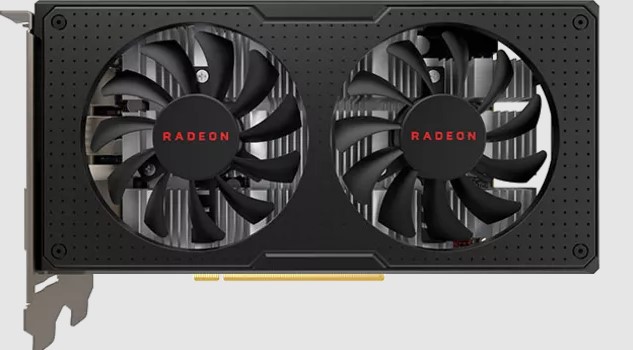
AMD has been developing CPUs, GPUs, and motherboard chipsets, among other things, for over half a century. It launched the Radeon RX 570 in April 2017. It featured the same GPU as the RX 580, but AMD chose to lock 256 cores to hit a specific shader target of 2,048. It was offered with two VRAM configurations, 4 and 8 GB.
Its 8 GB GDDR5 VRAM and DirectX 12 support mean, in theory, you can play all modern titles. Reality (and the 4 GB version) is another matter. It featured fourth-generation GCN cores, HBM2 (High Bandwidth Memory), HDR, and VR capabilities. Standing on its own, it’s not a bad card, but it’s not much of a match for the GTX 1060.
Pros:
- More cores
- More TMUs
- Larger bandwidth
- Larger VRAM
Cons:
- Slower VRAM
- Higher TDP
GTX 1060
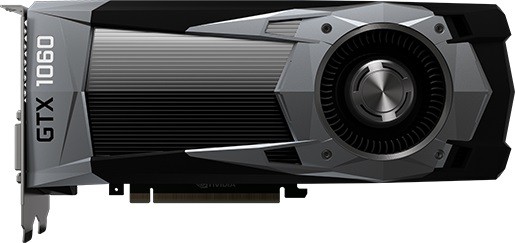
Nvidia was the first company ever to develop a GPU and has continued to produce them with flying colors, currently dominating the GPU landscape by all accounts. As it turns out, the GTX 1060 is like a little GPU series of its own, with eight versions of the card based on six GPU variants and seven VRAM configurations. Don’t worry, I’m confused too.
Nvidia originally launched the GeForce GTX 1060 6 GB in July 2016, followed by subsequent releases of various versions all the way up to October 2018. The core count remained the same in all of them, but VRAM configurations changed noticeably. The 1060’s 1,280 cores work at higher clock speeds but feature a smaller VRAM than the RX 570.
For any faults it may have, it’s still an immensely popular card to this day, a fact proven by its No.1 ranking among Steam users.
Pros:
- Faster cores
- Faster VRAM
- Better performance
- More purchasing options
Cons:
- Fewer cores
- Less VRAM
GTX 1060 vs RX 570 – Key Specifications
Architecture
Polaris
Polaris, or GCN 4.0, was the same as GCN 3.0 but with higher clock speeds. AMD achieved this thanks to advancements in the production process, allowing the same microarchitecture to function in a better way. The problem was that as time passed, AMD did nothing to give these cards more of a fighting chance in today’s market.
Pascal
In recent years, Nvidia has started focusing on more than gamers, now concentrating on AI and machine learning development. Pascal came after Nvidia’s focus shift, so it features a few bells and whistles that were designed for more but catered nicely to your gaming experience. Nvidia treated GTX 10 users to a DirectX Raytracing update in 2019 that enabled software-based raytracing (not very useful).
Winner: GTX 1060
Also Read: Differences between GTX and RTX Explained
Clock Speeds & Overclocking
Clock speed is the frequency at which a component, such as a GPU operates. The GTX 1060 (in all its variants) has higher clock speeds than the RX 570. Both have a “base” and “boost” clock. “Base” is your lowest speed, while “boost” is how much you can expect to achieve when you need some extra juice.
Both FE versions of the RX 570 have a base clock of 1,168 MHz and a boost clock of 1,244 MHz. All GTX 1060 FE versions have a base clock of 1,506 MHz and 1,709 MHz. Not bad, but if you still need more, you can bypass these speeds through overclocking.
A lot of third-party variants come factory-overclocked (look for the “OC” in the name). These can be overclocked too. Many people use MSI afterburner, but both AMD and Nvidia have their own dedicated software.
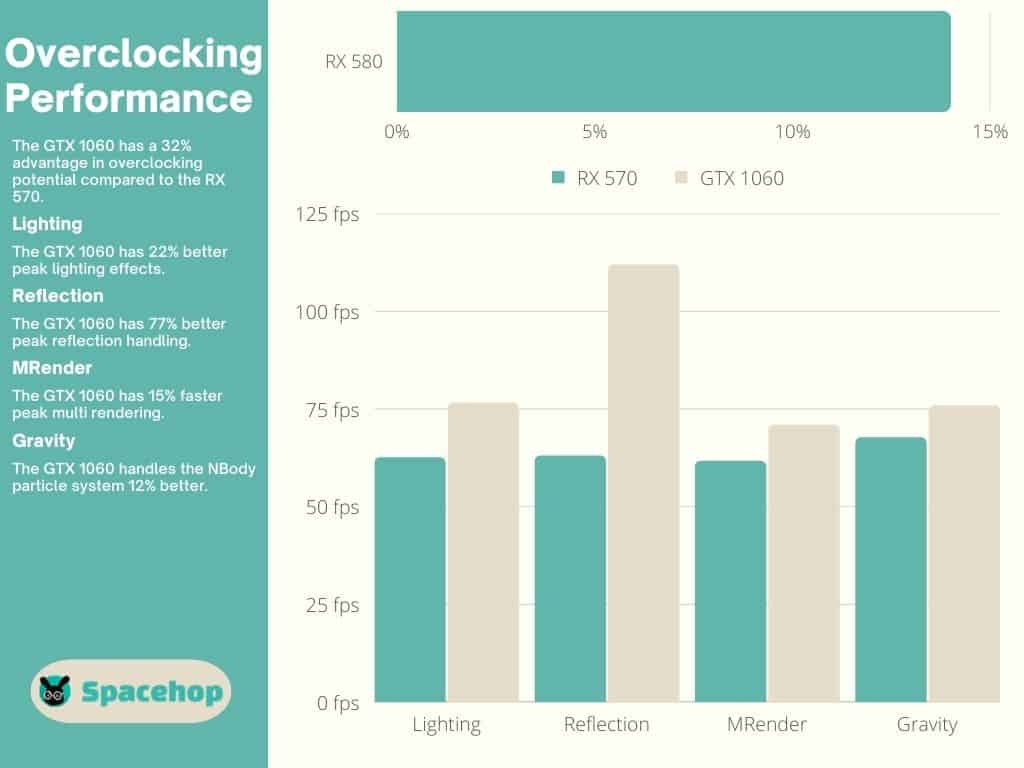
| Most powerful RX 570 versions | Boost clock | Most powerful GTX 1060 versions | Boost clock |
|---|---|---|---|
| Sapphire NITRO+ RX 570 8 GB | 1,340 MHz | EVGA GTX 1060 FTW+ ACX 3.0 | 1,860 MHz |
| ASUS ROG STRIX RX 570 GAMING OC 8 GB | 1,300 MHz | EVGA GTX 1060 FTW2+ w/ iCX Cooler | 1,860 MHz |
| XFX RS RX 570 Black Edition 8 GB | 1,286 MHz | EMTEK HV GTX 1060 WHITE MONSTER OC | 1,848 MHz |
| Sapphire PULSE RX 570 8 GB | 1,284 MHz | EMTEK XENON GTX 1060 Super JetStream FF14 | 1,848 MHz |
| Sapphire PULSE RX 570 V2 8 GB | 1,284 MHz | GALAX GTX 1060 HOF GOC Edition | 1,848 MHz |
Winner: GTX 1060
Also Read: How to Undervolt your CPU and GPU
Cores
Both RX 570 variants use the same GPU, which is also used in the RX 580. AMD chose to lock 256 cores to reach the target of 2,048 shaders planned for the RX 570. The GTX 1060 was produced using six different GPU variants, all of which have 1,280 cores. Even though the RX 570 has more cores, the GTX’s cores work at higher clock speeds, resulting in better performance.
Winner: RX 570
VRAM & Memory Specs
The GTX 1060 was produced in many versions. These included two 3 GB versions based on two different GPU variants; a 5 GB version (sold only in China); and three 6 GB versions, one of which had a GDDR5X VRAM and another with a memory clock speed of 2,257 MHz. All the other versions had 2,000 MHz. The basic 6 GB version with the GP106-400-A1 GPU was released first.
The RX 570 was produced in two versions, 4 and 8 GB. Both had a memory clock speed of 1,750 MHz. It was rumored that Nvidia planned to release an 8 GB version of the GTX 1060. It would be paired with a GDDR5X VRAM on a 256-bit BUS, delivering a bandwidth of 256.3 GB/s, but it was never released.
Winner: GTX 1060
Read Also: What’s the difference between VRAM and RAM?
Shaders, Ray Tracing Support, and TMUs
Shaders are generic programs designed to utilize GPU cores to create aspects critical to 3D rendering, most notably lights and shadows. Both cards, and all of their variants, use the same shader model (6.4), but because the RX 570 has more cores, it also has more shaders.
Ray tracing was only available in Nvidia RTX cards after it debuted in the Turing architecture. Nvidia chose to update some of its GTX cards with a DirectX Raytracing software patch. This included the GTX 1060, but ray tracing only slows down your EFps when activated due to its architecture. The RX 570 never got this update, nor did any AMD card featuring any type of ray tracing until the RX 6000 series.
TMU stands for Texture Mapping Units, and you guessed it, they handle textures. The RX 570 has over 50% more TMUs than the GTX 1060, resulting in better peak texture handling.
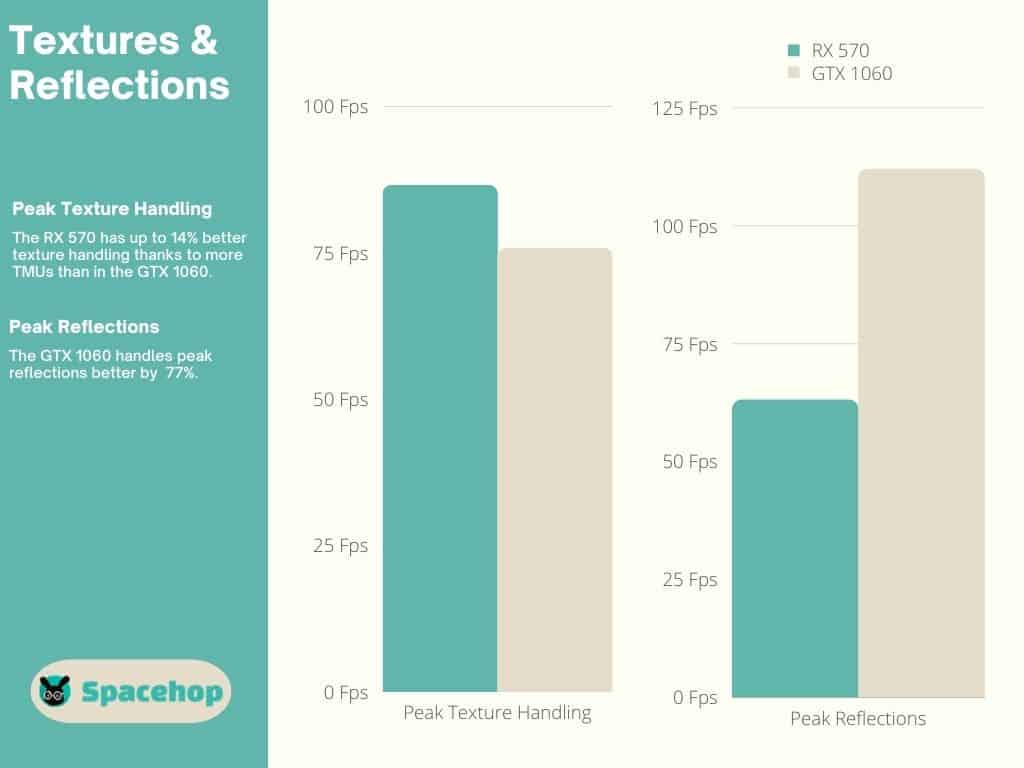
Winner: Draw
Performance
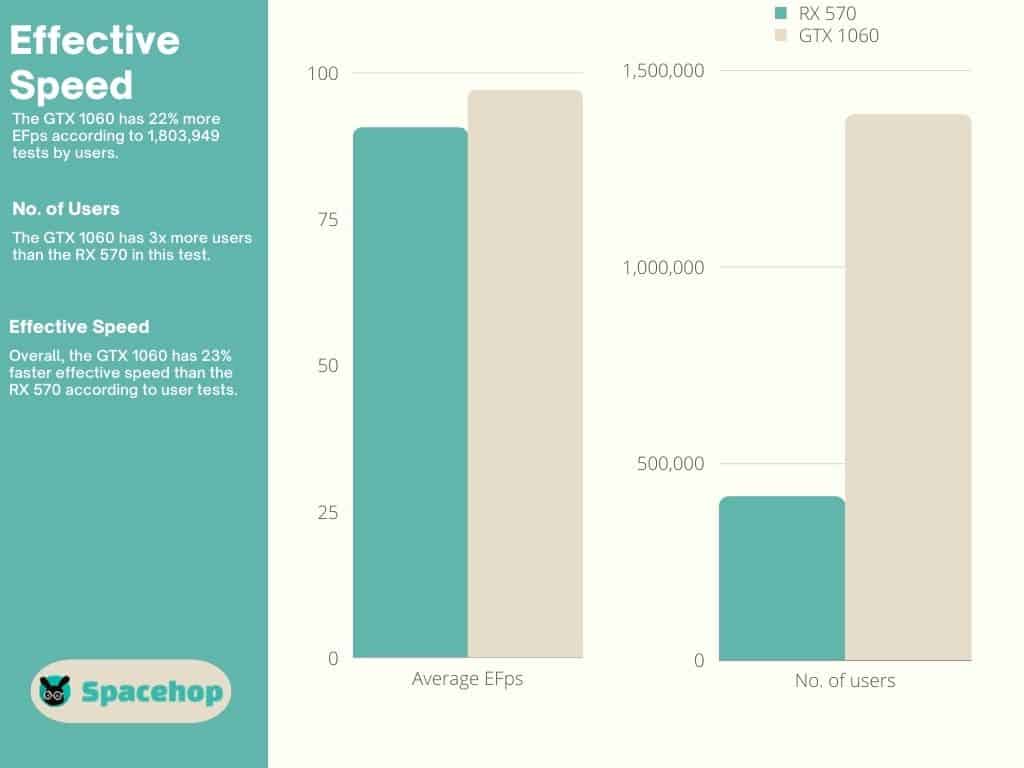
Here, there is no doubt about which card is better. Though performance results vary slightly depending on which variant of the GTX is compared to which RX 570 variant, the results are almost always in favor of the GTX 1060. To keep things simple, I showcased the RX 570 8 GB vs GTX 1060 6 GB results. Overall, users’ tests show the GTX 1060 has 22% better performance on average.
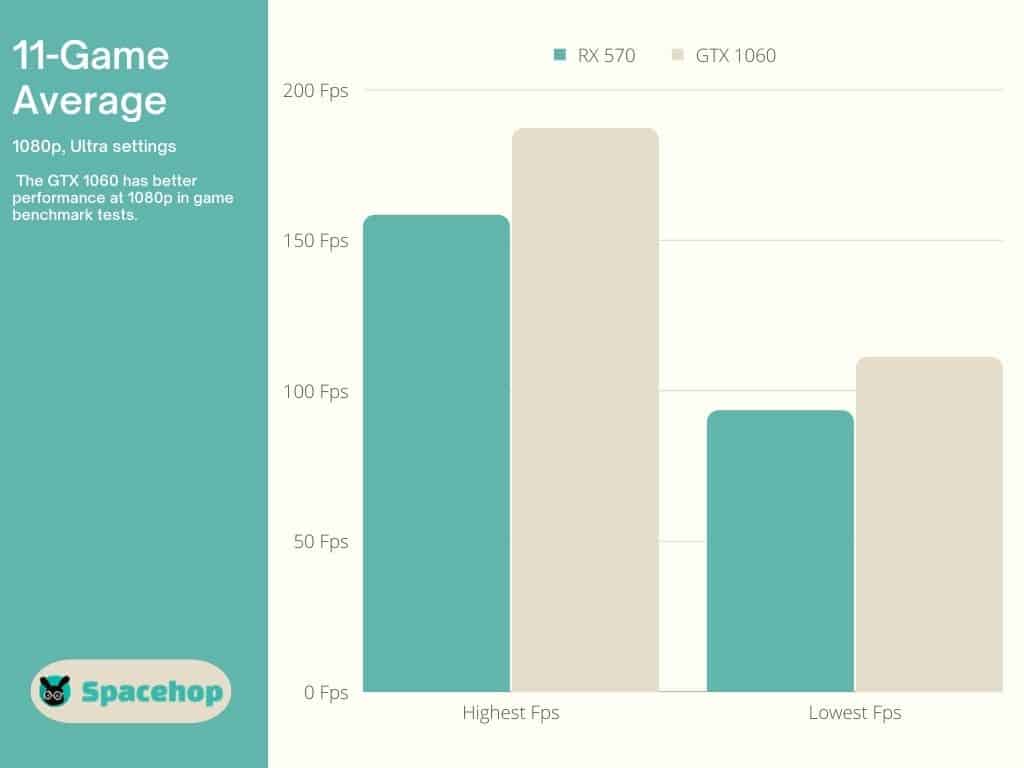
At 1080p, the GTX 1060 has 18.4% better average performance at ultra settings.
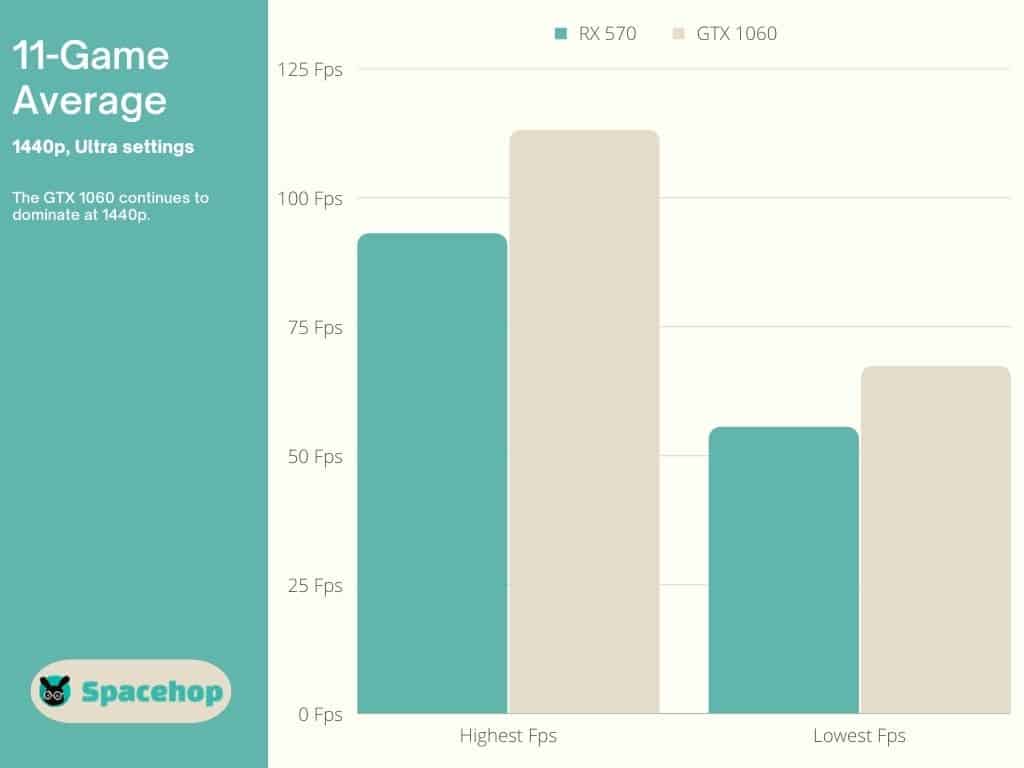
At 1440p, the GTX 1060 performs 22.4% better at ultra settings.
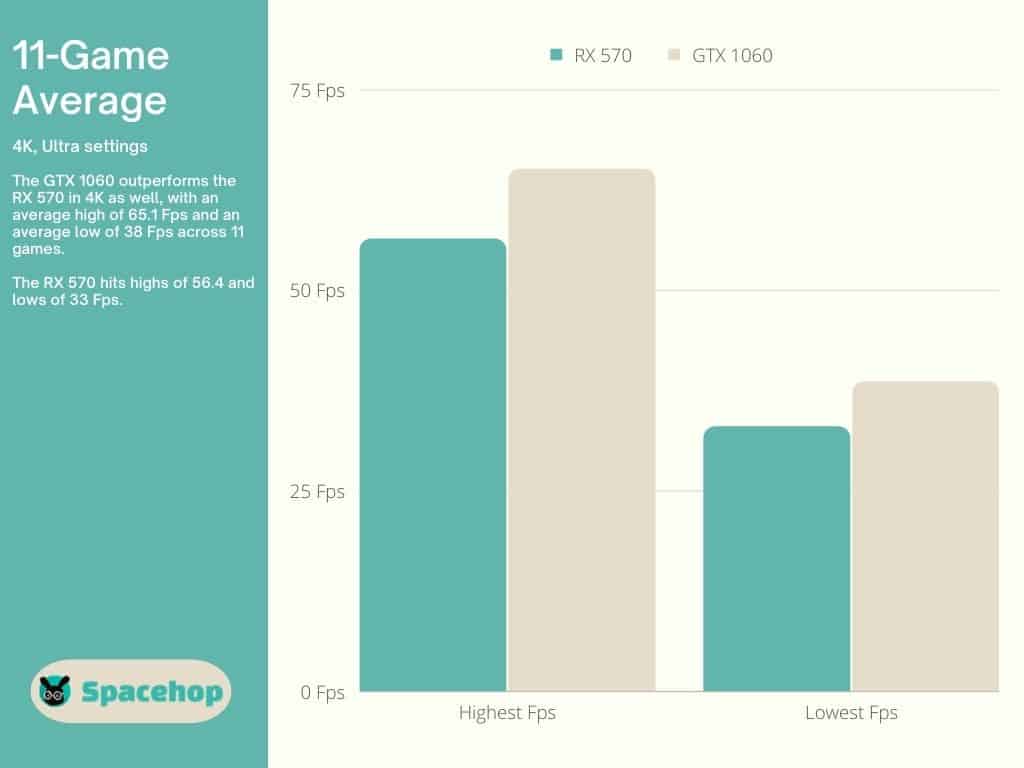
Neither card is a good performer at 4K, even if you’re playing titles from 10 years ago (on ultra). Results say that the GTX 1060 handles 4K better by 15.9% on average, but its lows drop down to 14 on some titles. Completely unplayable if you ask me.
Winner: GTX 1060
Also Read: Our RX 580 vs GTX 1060 comparison
Connectivity
Both the RX 570 and the GTX 1060 use 6-pin PSU connectors to draw enough power for their TDPs. Their output configurations are the same as well, with one DVI port, one HDMI port, and three DisplayPorts each.
Winner: Draw
TDP
Even though the GTX 1060 is the better performer, the RX 570 has a higher TDP. TDP refers to two things, Thermal Design Power and Thermal Design Point. The first is how much power a subsystem is allowed to draw from your PSU. The second is how much heat a subsystem is designed to produce and handle.
The RX 570 draws 150 W and requires a 450 W PSU (as stated by AMD). It also seems to produce slightly less heat, with 74℃ (165.2℉) being the highest temperature recorded during testing. The GTX 1060 draws 120 W and requires a 300 W PSU, and hits 76℃ (168.8℉) under the same loads during testing.
Winner: Draw
Standout Features
The GTX 1060 features DirectX Raytracing. In theory, this is great. In reality, games become almost unplayable when you activate ray tracing.
GTX 1060 vs RX 570 – Pricing & Availability
The mid-range RX 570 was released with a $169 MSRP. The GTX 1060 6 GB launched at $299. Nowadays, you can forget about these prices, and there aren’t even that many RX 570s around. I found two. One MSI Gaming variant is priced 136% above the MSRP, and this third-best variant ever produced, the XFX Black Edition, is priced 402% above the MSRP. WOW!
The GTX 1060 has prices that are all over the place. This ASUS ROG Strix variant is priced 76% above the MSRP. This EVGA SC Gaming variant is priced 28% below the MSRP. I found several deals priced below the MSRP, including one from ASUS, an ASUS Turbo Edition, an MSI Gaming, and this GIGABYTE Gaming variant.
Conclusion
All things considered, I think neither of these cards or any of their variants are good investments in 2022. This RX 570 vs GTX 1060 comparison has shown that they can’t handle titles from 2018 without lowering settings or cutting down on EFps, let alone more recent titles or those yet to come out.
Recently we’ve witnessed drops in prices of the latest cards from both AMD and Nvidia, and you can grab them for below $400 when on sale, some even for $300 on a good day.
If you’re adamant about buying one of these cards, I recommend the GTX 1060. It has better performance, costs much less on average, and is available in various configurations, leaving you with more options to choose from. Not to mention the difference in availability on the market, which is also in the GTX 1060’s favor.